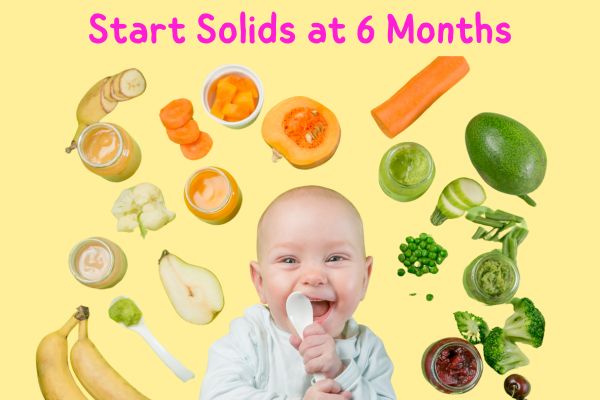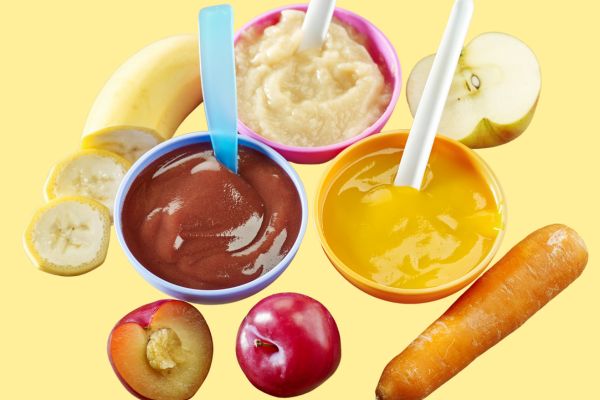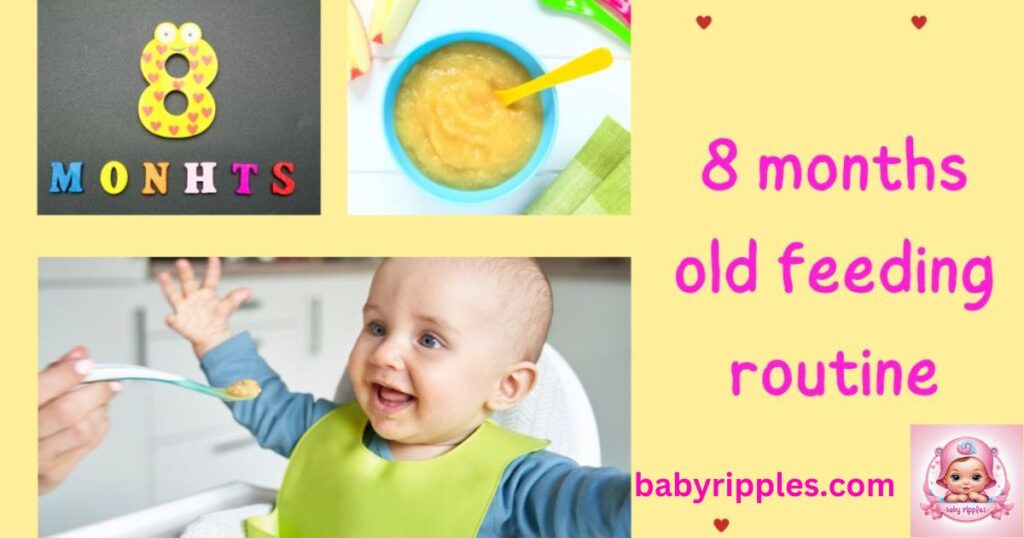Introducing solids to your 6-month-old baby is an exciting milestone, marking their transition to exploring new flavors and textures. 8 Month Old Feeding Routine builds on this stage, adding more variety to their diet. While breast milk or formula remains the primary source of nutrition at this stage, incorporating solid foods is essential for development. Here’s a detailed guide covering nutritious meal ideas for your little one, ensuring a balanced diet and a joyful feeding experience.
Why Start Solids at 6 Months?
Starting solids at around 6 months is a crucial milestone in your baby’s growth and development. While breast milk or formula provides all the necessary nutrients during the first few months, there are several reasons why introducing solids at this age is important:
1. Nutritional Needs Increase
At around 6 months, your baby’s iron stores, which were built up during pregnancy, begin to deplete. Iron-rich foods, such as pureed meats, cereals, and vegetables, are necessary to meet your baby’s growing nutritional needs.
2. Development of Oral Skills
Introducing solid foods at 6 months helps babies develop essential oral motor skills. Chewing and swallowing new textures prepares them for more complex foods later on. It also encourages the development of facial muscles, which are crucial for speech and eating.
3. Supports Growth and Development

Solid foods provide additional nutrients like zinc, vitamins, and healthy fats, which are essential for brain development, immune system support, and overall physical growth. As babies start eating solids, they gain the extra energy required to continue growing at a healthy pace.
4. Encourages Exploration of New Flavors
Starting solids opens the door to a variety of tastes and textures, which helps babies develop their sense of taste and preference. Early exposure to different foods can also reduce the chances of developing food sensitivities or preferences later on.
5. Establishing Healthy Eating Habits
Introducing solids helps to lay the foundation for healthy eating habits. Babies learn to associate eating with positive experiences, and early exposure to nutritious foods can shape their long-term food choices.
By starting solids at 6 months, you give your baby the opportunity to thrive physically, emotionally, and nutritionally as they embark on the exciting journey of exploring new foods. Always consult your pediatrician before beginning solids to ensure your baby is ready.
Key Nutrients for 6-Month-Olds
When planning meals, focus on essential nutrients to support growth and development:
- Iron: Needed for healthy brain development (found in fortified cereals, spinach, and meat).
- Calcium: Important for bone development (available in dairy and some leafy greens).
- Healthy Fats: Crucial for brain development (present in avocado and fish).
First Foods to Introduce

Introduce single-ingredient foods first to monitor potential allergies. Here are some great starter foods:
1. Vegetables
- Carrots: Rich in beta-carotene and easy to digest.
- Sweet Potatoes: A creamy and nutrient-packed option.
- Zucchini: Mild-flavored and soft when steamed.
2. Fruits
- Bananas: Naturally sweet and easy to mash.
- Apples: Cooked or pureed for easier digestion.
- Pears: Gentle on the tummy and hydrating.
3. Grains and Cereals
- Rice Cereal: A traditional starter fortified with iron.
- Oatmeal: A fiber-rich alternative to rice cereal.
4. Protein Sources
- Lentils: Pureed or mashed for a soft texture.
- Chicken: Pureed or finely shredded for easy consumption.
- Egg Yolk: Introduce after consulting your pediatrician.
Sample Meal Plan for a 6-Month-Old Baby
Below is a sample feeding schedule, combining breast milk/formula with solids:
| Time | Meal | Notes |
|---|---|---|
| 8:00 AM | Breast milk or formula | Primary nutrition source |
| 10:00 AM | Mashed banana or avocado | Start with 1–2 teaspoons |
| 12:30 PM | Breast milk or formula | Full feeding session |
| 2:30 PM | Sweet potato puree | Gradually increase portion size |
| 5:00 PM | Breast milk or formula | Ensure baby stays hydrated |
| 6:30 PM | Rice cereal mixed with breast milk | Offer before bedtime feeding |
Meal Preparation Tips
- Use Fresh Ingredients: Opt for organic produce when possible.
- Avoid Salt and Sugar: Babies’ kidneys can’t process excess sodium, and sugar isn’t necessary at this stage.
- Cook Thoroughly: Ensure food is soft and easy to swallow.
Texture Progression
- Stage 1 (6–7 Months): Pureed and mashed foods.
- Stage 2 (7–8 Months): Slightly chunkier textures.
- Stage 3 (8–9 Months): Finger foods and small chunks.
Creative Meal Ideas

Vegetable-Based Recipes
- Carrot and Pea Mash:
- Steam carrots and peas until tender.
- Blend into a smooth puree.
- Butternut Squash Soup:
- Boil squash and puree with a little water.
Fruit Combos
- Apple and Pear Puree:
- Cook both fruits together and blend.
- Serve warm or chilled.
- Banana and Avocado Mash:
- Mash ripe banana with avocado for a creamy delight.
Protein-Rich Ideas
- Chicken and Sweet Potato Blend:
- Cook chicken thoroughly, shred, and mix with sweet potato.
- Lentil Soup:
- Boil lentils with a pinch of turmeric and puree.
Foods to Avoid
- Honey: Risk of botulism.
- Cow’s Milk: Difficult to digest before one year.
- Whole Nuts: Choking hazard.
- Citrus Fruits: May cause diaper rash due to acidity.
Introducing Allergenic Foods
To identify allergies early, introduce these foods one at a time:
- Peanuts (in the form of peanut butter).
- Eggs (well-cooked).
- Fish (cooked thoroughly).
Monitor your baby for reactions like rashes, vomiting, or swelling.
5 FAQs About Meal Ideas for 6-Month-Old Babies
1. How much food should a 6-month-old eat?
Start with 1–2 teaspoons per meal and gradually increase to 1–2 tablespoons.
2. Can I add spices to my baby’s food?
Mild spices like cinnamon or turmeric are safe, but avoid salt and sugar.
3. How do I store baby food?
Use airtight containers and refrigerate for up to 48 hours. Freeze larger batches for later use.
4. Should I offer water at this age?
Small sips of water can be introduced, especially if your baby is formula-fed.
5. What if my baby refuses solids?
Be patient. Offer the same food multiple times and experiment with different textures.
Final Thoughts
Feeding your 6-month-old is a journey of discovery for both you and your baby. By introducing a variety of flavors, textures, and nutrients, you lay the foundation for a lifetime of healthy eating habits. Always consult your pediatrician before introducing new foods, especially allergenic ones, and enjoy this special milestone in your parenting journey.





